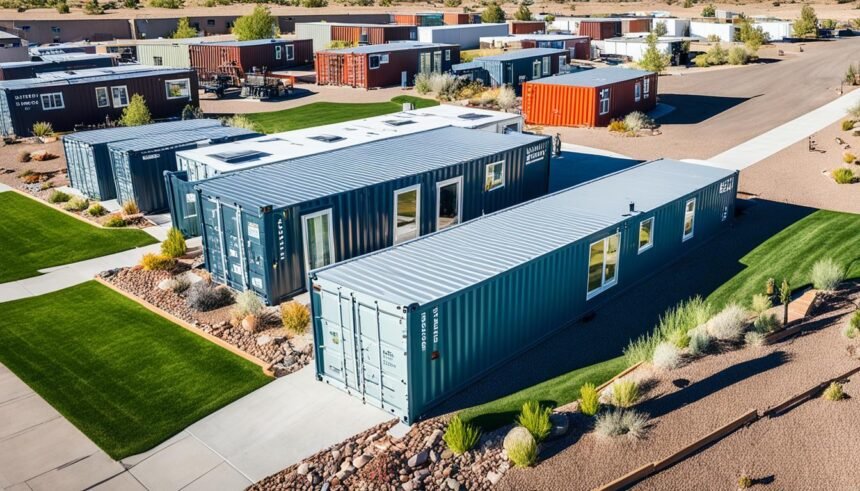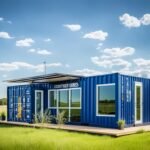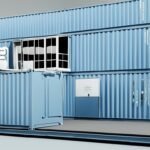Welcome to our article exploring the legal status of container homes in New Mexico. Container homes have gained popularity in recent years as an affordable and sustainable housing option. However, before embarking on a container home project in New Mexico, it is crucial to understand the regulations and laws that govern their construction and use.
Key Takeaways:
- Container homes in New Mexico are subject to specific laws and regulations.
- It is important to familiarize yourself with the zoning laws that affect container home construction in New Mexico.
- Obtaining the necessary permits from local authorities is a crucial step in building a container home legally.
- Compliance with building codes is essential to ensure the safety and integrity of container homes in New Mexico.
- Environmental considerations, including sustainability and waste management, should be taken into account when constructing a container home.
Understanding container homes
Container homes have gained popularity in recent years for their unique construction and aesthetic appeal. These innovative dwellings are made from shipping containers, providing a sustainable and cost-effective housing solution. However, before embarking on the journey of building a container home in New Mexico, it is crucial to understand the legal requirements associated with this type of construction.
When it comes to the legality of shipping container homes, each state and municipality has its own set of regulations and guidelines. New Mexico is no exception. To ensure compliance with the law, it is essential to familiarize yourself with the container house legal requirements specific to the state. This will help you avoid any legal issues and ensure that your container home meets all necessary standards.
Construction and Unique Features of Container Homes
A container home is constructed using steel shipping containers that were originally designed for transporting goods across the globe. These containers are repurposed and transformed into comfortable living spaces, often featuring an open floor plan with carefully designed layouts. Container homes can be customized to suit individual preferences and can vary in size, design, and functionality. From single-unit homes to multi-level structures, the possibilities are endless.
Container homes offer several unique features that make them appealing to homeowners. These include:
- Cost-effectiveness: Building a container home can be significantly more affordable compared to traditional construction methods. The reuse of shipping containers reduces material costs and construction time, making it an attractive option for those on a budget.
- Sustainability: Repurposing shipping containers helps reduce waste and limit the consumption of new materials. Container homes are considered eco-friendly as they contribute to recycling efforts and minimize the carbon footprint associated with construction.
- Flexibility: Container homes offer the flexibility to be relocated if necessary. The modular nature of shipping containers allows for easy transportation, making it possible to move your living space to a new location.
“Container homes provide an innovative solution for sustainable and affordable housing. They offer a unique blend of functionality, versatility, and style.” – John Davis, Architect
Legal Requirements for Building Container Homes in New Mexico
Building a container home in New Mexico requires adherence to specific legal requirements. These requirements ensure the safety, structural integrity, and compliance of the dwelling with local regulations. Some of the key legal aspects to consider include:
- Zoning and land-use regulations: Before building a container home, it is essential to determine if the intended location is zoned for residential use and permits container homes. Zoning laws vary between municipalities, so it is necessary to consult with local authorities or an experienced professional to ensure compliance.
- Building permits: Obtaining the necessary building permits is crucial when constructing a container home in New Mexico. Building codes and regulations dictate the specific requirements for construction, including structural stability, electrical installations, plumbing systems, and insulation.
- Foundation requirements: Container homes must be securely anchored to a suitable foundation to ensure stability and minimize the risk of structural damage. The foundation requirements can vary depending on the specific location and soil conditions.
By understanding and meeting these legal requirements, you can ensure that your container home project complies with New Mexico’s laws and regulations. It is advisable to work with professionals experienced in container home construction who can guide you through the legal process and ensure compliance with all necessary legal requirements.
| Benefits of Container Homes | Challenges of Container Homes |
|---|---|
| 1. Cost-effectiveness | 1. Limited size and layout options |
| 2. Sustainability | 2. Structural modifications and reinforcements may be needed |
| 3. Flexibility | 3. Potential difficulties in obtaining financing and insurance |
| 4. Quick construction time | 4. Perceived social stigma |
As with any housing option, container homes have their own set of benefits and challenges. The table above provides a comparison of some key advantages and limitations of container homes to help you make an informed decision based on your specific needs and priorities.
Zoning laws for container homes in New Mexico
When considering building a container home in New Mexico, it is crucial to understand the zoning laws that govern this type of construction. Zoning laws determine the designated land use for a specific area and can have a significant impact on where container homes can be built.
In New Mexico, zoning laws vary from one municipality to another, so it’s important to research and comply with the regulations specific to your location. Some areas may have specific zones where container homes are permitted, while others may have restrictions or outright bans.
To determine the zoning regulations for container homes, you can consult the local planning department or zoning board in your area. They will provide information on the specific zoning districts and any restrictions or requirements that apply to building and living in a container home.
It’s important to note that zoning laws may dictate factors such as minimum lot size, setbacks, height restrictions, and architectural guidelines. These requirements ensure that container homes blend harmoniously with the existing neighborhood and meet safety standards.
Zoning regulations for container homes in New Mexico:
| Zoning District | Container Home Permitted | Restrictions |
|---|---|---|
| Rural Residential | Yes | May require minimum lot size of 1 acre |
| Urban Residential | Yes, with restrictions | Setbacks from property lines, maximum height limitations |
| Commercial | No, except for mixed-use developments | Only allowed as part of a larger development plan |
It’s important to consult the specific zoning regulations for your area, as the information provided here is for illustrative purposes only. By understanding and complying with the zoning laws, you can ensure a smooth construction process and avoid any potential legal issues.
Remember to seek guidance from professionals such as architects, designers, and legal experts who are well-versed in container home zoning laws in New Mexico. This will help you navigate the complexities of local regulations and ensure compliance.
Building permits for container homes
When it comes to constructing a container home in New Mexico, obtaining the necessary building permits is an important step in ensuring compliance with local regulations. Building permits are required to ensure the safety and structural integrity of the container home, as well as to ensure that it meets the appropriate codes and standards.
The process of obtaining a building permit for a container home in New Mexico involves several steps. First, you will need to submit an application to the relevant local building department. This application typically includes detailed plans and specifications of the container home, as well as information about the land on which it will be located. The building department will review the application and conduct inspections to ensure that the proposed construction meets all relevant building codes and zoning regulations.
It is important to note that the specific building permit requirements for container homes in New Mexico may vary depending on the local jurisdiction. Some areas may have specific regulations in place that are unique to container homes, while others may apply existing building codes to these structures. Therefore, it is crucial to research and understand the specific regulations in your area before starting the permit application process.
Key Considerations for Building Permits
- Structural Stability: The container home must meet the structural stability requirements set forth by the building department. This includes ensuring that the containers are properly reinforced, and that any modifications do not compromise the overall integrity of the structure.
- Electrical and Plumbing: Container homes must also comply with electrical and plumbing codes. This means that the electrical wiring, outlets, and plumbing systems must meet the required safety standards.
- Fire Safety: Fire safety regulations must be adhered to when building a container home. This may include the installation of fire-resistant materials, smoke detectors, and fire extinguishers.
- Zoning and Land Use: Container homes must comply with the zoning and land use regulations of the specific area in which they are located. It is important to ensure that the intended site is zoned for residential use and that the container home meets any setback requirements.
By obtaining the necessary building permits for your container home, you can ensure that your project is in compliance with the law and that it meets the required safety and quality standards.
“Building permits are essential to ensure the safety and compliance of container homes in New Mexico. It’s crucial to understand and follow the specific regulations in your area to avoid potential legal issues and ensure a smooth construction process.” – Sarah Thompson, Container Home Builder
Now that we’ve covered the building permit requirements for container homes, let’s move on to discussing the importance of complying with building codes.
| Permit Requirements Checklist | Documents Needed |
|---|---|
| Completed building permit application | Architectural plans and specifications |
| Evidence of land ownership or lease | Structural engineering calculations and drawings |
| Proof of compliance with zoning regulations | Electrical and plumbing plans |
Now that we have a clear understanding of the building permit requirements for container homes, let’s delve into the importance of complying with building codes.
Compliance with building codes
When embarking on the construction of a container home in New Mexico, it is crucial to understand and adhere to the building codes and regulations in place. These codes ensure the structural integrity, safety, and sustainability of the container home, as well as the overall well-being of its occupants.
Container homes, just like traditional homes, must meet certain standards set by the local authorities. Failure to comply with these codes can result in penalties, fines, and even the condemnation of the property. Therefore, it is essential to prioritize compliance and ensure that your container home meets all the necessary requirements.
One of the primary reasons for building codes is to ensure the safety of the occupants. Building codes encompass various aspects, including structural integrity, electrical and plumbing systems, fire safety measures, and accessibility. Each of these areas has specific regulations that must be followed during the construction process.
In New Mexico, container homes are subject to the same building codes as traditional homes. These codes are enforced at the county level and may vary slightly from one county to another. It is crucial to consult the local building department or a qualified professional to understand the specific codes and regulations applicable to your area.
Meeting Structural Requirements
One of the key considerations when constructing a container home is ensuring its structural stability. Since shipping containers are repurposed for living spaces, they may require additional structural modifications to meet building code requirements. This may involve reinforcing the walls, adding support beams, or installing proper insulation.
Structural requirements also extend to the foundation of the container home. The foundation must be designed to accommodate the weight and dimensions of the containers, ensuring stability and preventing shifting or settling over time. It is essential to work with a qualified architect or structural engineer to ensure that the foundation meets the necessary standards.
Electrical and Plumbing Systems
Another crucial aspect of building code compliance for container homes is the installation of electrical and plumbing systems. These systems must be designed and installed by licensed professionals to meet the necessary safety standards.
Electrical wiring must conform to the National Electrical Code (NEC) and be inspected by a certified electrician. This ensures that the electrical system is safe, properly grounded, and capable of meeting the demands of the container home.
Similarly, the plumbing system must meet local plumbing codes and be installed by a licensed plumber. This ensures that the water supply, drainage, and waste disposal systems are functional, sustainable, and in compliance with all health and safety regulations.
Fire Safety Measures
Fire safety is a critical consideration for any home, including container homes. Building codes often include regulations for fire-resistant materials, smoke detectors, fire extinguishers, and proper egress routes. These measures are in place to protect the occupants and neighboring properties in the event of a fire.
When constructing a container home, it is important to implement fire safety measures as required by the building codes. This may involve using fire-rated insulation, installing smoke detectors in every room, and ensuring unobstructed exits.
Complying with building codes is essential not only during the construction phase but also for obtaining necessary permits and approvals. Building departments in New Mexico typically require inspections at various stages of the construction process to verify compliance with the relevant codes. Non-compliance can lead to delays, additional expenses, and legal issues.
By prioritizing compliance with building codes, you can ensure the safety, longevity, and legality of your container home in New Mexico.
Environmental considerations
When it comes to container homes in New Mexico, there are important environmental considerations to keep in mind. These considerations include regulations and requirements related to sustainability, energy efficiency, and waste management.
Sustainability is a key aspect of container home construction, as it aligns with the need for environmentally-friendly housing solutions. To ensure compliance with container homes legal regulations in New Mexico, it’s essential to design and build homes that minimize their impact on the environment.
An important requirement is energy efficiency, as it not only reduces the carbon footprint of container homes but also contributes to long-term cost savings for homeowners. Insulation, proper ventilation, and energy-efficient appliances are just a few aspects to consider when designing an energy-efficient container home in New Mexico.
Waste management is another crucial consideration. Proper waste disposal and recycling practices must be followed throughout the construction process, from the initial site preparation to the completion of the container home. Compliance with New Mexico container home laws ensures that waste is handled responsibly and does not harm the local environment.
Quotes:
“Building sustainable and energy-efficient container homes not only benefits the environment but also provides homeowners with long-term cost savings.”
Environmental Considerations Checklist
| Environmental Considerations | Regulatory Requirements |
|---|---|
| Sustainability | Adherence to green building standards |
| Energy Efficiency | Compliance with energy codes and use of energy-efficient materials and appliances |
| Waste Management | Proper disposal and recycling of construction waste |
Insurance requirements for container homes
When considering the construction of a container home in New Mexico, it is essential to understand the insurance requirements that come with it. Adequate insurance coverage ensures that your investment is protected and that you comply with the necessary legal regulations. Let’s explore the types of insurance coverage that may be necessary for container homes and any specific regulations related to insurance in New Mexico.
Type of Insurance Coverage
Container homes, like traditional homes, require various types of insurance coverage to safeguard against potential risks. The following are some recommended insurance policies for container homes:
- Homeowners Insurance: Homeowners insurance provides coverage for property damage and liability in case of accidents or injuries on your property.
- Building Insurance: Building insurance protects the physical structure of the container home and covers any damage caused by fire, natural disasters, vandalism, or theft.
- Contents Insurance: Contents insurance covers the belongings inside your container home, including furniture, appliances, and personal belongings.
- Liability Insurance: Liability insurance protects you from legal claims filed by visitors who sustain injuries or property damage while on your premises.
These insurance policies are essential to protect both your property and yourself from unforeseen circumstances.
Specific Insurance Regulations in New Mexico
While there are no specific insurance regulations that exclusively apply to container homes in New Mexico, it is important to meet the requirements set by insurance providers. Each insurance company may have its own guidelines and prerequisites for insuring container homes.
To ensure compliance with insurance regulations in New Mexico, consider the following:
- Work with insurance providers who have experience insuring non-traditional homes, such as container homes.
- Disclose all relevant information about your container home, including its construction materials, modifications, and safety features.
- Ensure that your container home meets the necessary safety standards and building codes outlined by local authorities.
- Keep detailed records of your container home’s construction, including photographs, certifications, and engineering reports.
By following these guidelines, you can ensure that your container home meets the insurance requirements in New Mexico.
Remember, it’s always recommended to consult with insurance professionals who specialize in non-traditional homes to ensure you have the appropriate coverage for your container home.
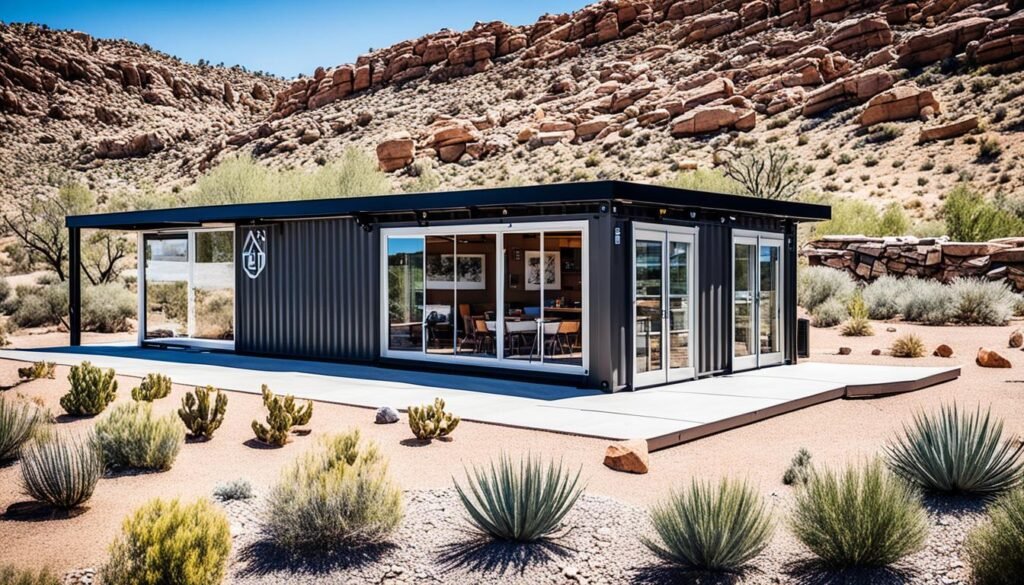
| Insurance Provider | Required Coverage | Additional Notes |
|---|---|---|
| ABC Insurance | Homeowners Building Contents Liability |
Experienced in insuring container homes |
| XYZ Insurance | Homeowners Building |
Requires proof of compliance with local building codes |
| 123 Insurance | Homeowners Contents Liability |
No specific requirements for container homes |
Challenges and limitations of container homes in New Mexico
While container homes offer unique advantages, such as affordability and sustainability, they also come with their fair share of challenges and limitations in the context of New Mexico. Understanding these hurdles is crucial for those considering container home construction in the state.
Building Restrictions
New Mexico has specific building regulations that container homes must comply with. These regulations aim to ensure the safety and structural integrity of residential buildings. Maintaining compliance with these restrictions can sometimes pose challenges to container home builders, as modifications and reinforcements may be necessary to meet the state’s building codes.
Financing Options
Securing financing for container home projects in New Mexico can be more challenging compared to traditional homes. While container homes are gaining popularity, some lenders may still be hesitant to provide loans for unconventional structures. It is essential to explore alternative financing options such as personal loans, specialized lenders, or crowdfunding platforms to overcome this limitation.
Public Perception
Despite their growing popularity, container homes may still face skepticism from some members of the public. This mistrust can lead to challenges when it comes to finding suitable locations for container home projects within established neighborhoods. Overcoming negative perceptions and educating the community about the benefits of container homes is key to gaining wider acceptance and support.
“Container homes offer creative and sustainable solutions to address the increasing demand for affordable housing. However, navigating the challenges and limitations within New Mexico’s legal landscape requires careful planning, research, and collaboration with local authorities.”
Addressing these challenges and limitations requires proactive engagement with local authorities, architects, builders, and the community. Fortunately, with the right approach and proper adherence to legal regulations, container homes can provide a unique, affordable, and environmentally conscious housing solution in New Mexico.
Case studies of container homes in New Mexico
In this section, we will showcase real-life case studies of container homes that have been successfully built and approved in New Mexico. These examples highlight the innovative design and construction aspects of container homes, while also emphasizing the legal considerations that were addressed in the process.
Case Study 1: The Serenity Container Home
The Serenity Container Home, located in Albuquerque, New Mexico, is a stunning example of sustainable living through container home construction. Designed and built by GreenSpace Container Homes, this 3-bedroom, 2-bathroom home incorporates eco-friendly features, including solar panels and rainwater harvesting systems.
The construction of the Serenity Container Home complied with all legal regulations and New Mexico container home laws. The design team worked closely with local authorities to ensure that the home met all building codes and zoning requirements.
“Building our container home in New Mexico was a smooth process, thanks to the support and guidance provided by the local authorities. Our home not only showcases the versatility of container homes but also demonstrates that they can meet all legal requirements and regulations.”
Case Study 2: The Mesa Vista Retreat
Nestled amidst the picturesque landscapes of Taos, New Mexico, the Mesa Vista Retreat is an exemplary container home that seamlessly blends with its surroundings. This 2-bedroom, 1.5-bathroom home was designed by StudioTRK Architects and built with sustainability and energy efficiency in mind.
The Mesa Vista Retreat underwent a comprehensive review and approval process to ensure compliance with all container homes legal regulations in New Mexico. The design team collaborated with local building officials to address any concerns and ensure that the home met all necessary codes and requirements.
Design Features:
- Integration of natural materials, such as reclaimed wood and stone, to enhance the aesthetic appeal
- Passive solar design for optimal energy efficiency
- Incorporation of large windows to maximize natural light and capture breathtaking views
These case studies provide tangible evidence that container homes can be legally constructed and approved in New Mexico. By partnering with experienced professionals and working closely with local authorities, container home enthusiasts can create unique and compliant living spaces that reflect their vision and values.
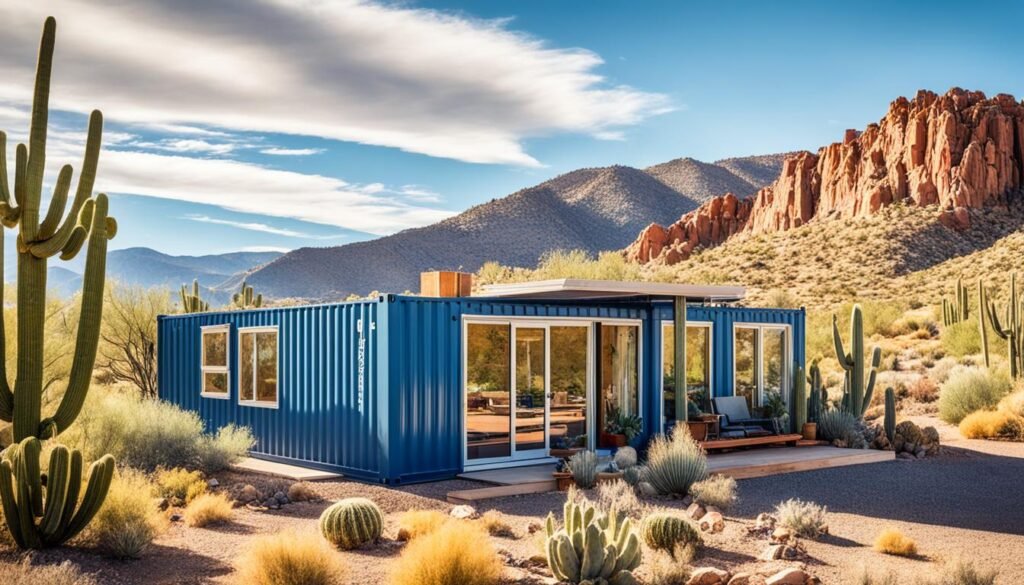
Future prospects for container homes in New Mexico
As container homes continue to gain popularity, the future prospects for this unique housing option in New Mexico look promising. With the increasing recognition of container homes as sustainable and affordable alternatives, there is a growing interest in exploring and updating the existing legal regulations to accommodate this trend.
One potential area of future development is the expansion of zoning laws to include specific provisions for container homes. Currently, container homes in New Mexico are subject to the same zoning regulations as traditional homes. However, there is a possibility that local authorities may adopt new zoning guidelines that address the unique characteristics and requirements of container homes.
Moreover, the state government of New Mexico acknowledges the importance of sustainable and energy-efficient construction practices. In the future, we may see the implementation of new regulations and incentives to encourage the use of container homes as an eco-friendly housing solution. This could include tax incentives, grants, or subsidies for individuals and developers who choose to invest in container home projects.
Additionally, with the ongoing advancements in building technology and design, container homes are becoming more innovative and aesthetically pleasing. This opens up opportunities for collaboration between architects, builders, and container home enthusiasts to create modern and stylish container home communities.
“Container homes have the potential to revolutionize the way we think about housing. They offer an affordable, sustainable, and customizable alternative that can help address the housing shortage in New Mexico.”
– John Martinez, Architect
Overall, the future of container homes in New Mexico appears bright. With a growing recognition of their benefits and potential, it is likely that we will witness further integration of container homes into mainstream housing options. It will be interesting to see how the legal regulations evolve to embrace and support this innovative housing solution.
| Prospects | Opportunities | Challenges |
|---|---|---|
| Expansion of zoning laws | Tax incentives | Building restrictions |
| Innovative design possibilities | Grants and subsidies | Financing options |
| Increased collaboration | Eco-friendly regulations | Public perception |
Conclusion
To conclude, this article has provided an overview of the legality of container homes in New Mexico. We have explored the regulations, permits, and legal considerations that need to be taken into account when building and living in a container home in the state.
It is clear that container homes can be a viable housing option in New Mexico; however, it is crucial to adhere to the zoning laws, obtain the necessary building permits, and ensure compliance with building codes. By doing so, individuals can mitigate any potential challenges and limitations that may arise during the construction process.
It is also important to stay updated with the latest laws and regulations to ensure ongoing compliance. As container homes continue to gain popularity for their affordability and sustainability, it is likely that the legal landscape will evolve. By staying informed, individuals can make informed decisions and navigate the container home building process with confidence.
In conclusion, building and living in a container home in New Mexico is an exciting and innovative option for those looking for an alternative housing solution. By understanding the legal requirements and following the necessary steps, individuals can create a comfortable and legal container home that fits their lifestyle and contributes to a more sustainable future.

